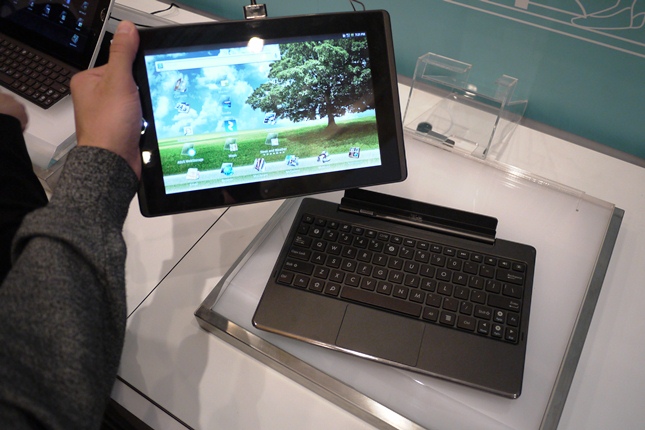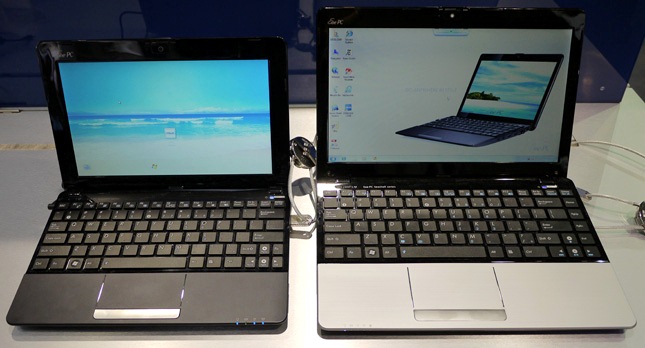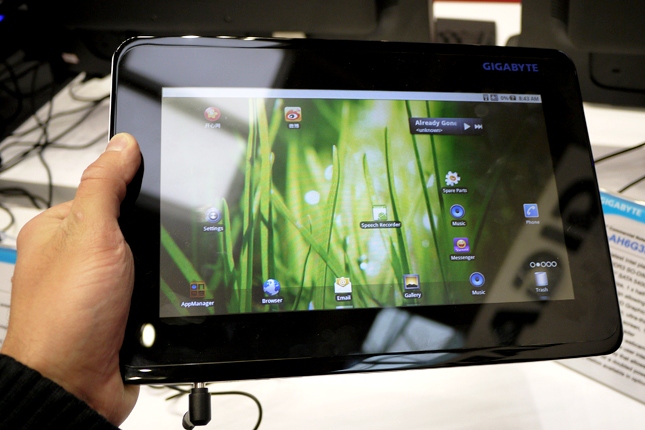CeBIT 2011: Android girl, tablets, wireless monitor and other new items
On March 5th in German Hannover, CeBIT 2011 ended. I flew to Germany the night before and first went with a video camera to the still unfinished exhibition pavilions:
Next - more interesting: a monitor that works without wires, the AILA android girl, a full-sized GLONASS satellite layout and .
')
Here, in theory, there should be a paragraph devoted to why thehell is why the exhibition ended on March 5, and I am posting this post just now. Let me explain: I shot a lot of things and the last (but not the last!) Material was posted on the site quite recently. And at CeBIT 2011, in contrast to the Mobile Congress, there was nothing “hot” - most of what was shown at the exhibition will be relevant in a month.
At one time, CeBIT was one of the largest consumer electronics exhibitions in the world. Today, it is arranged for the most part in order to reduce those who need money (software developers, hardware, technology) with those who have this money.
And now about everything in order. Or rather, alphabetically:
AMD has brought at CeBIT 2011 six fairly fresh laptops and a bold green Toshiba NB550D netbook - all on the Fusion platform. I asked Mikhail Lishiecki, product manager at AMD, to tell you what the new items are good for:
At the stand of Archos tablets were so many that my eyes ran. The company brought to the exhibition the device, not only under its own brand, but also new items under the Arnova brand. The PR manager of the company told me how Arnova differs from Archos, what is special about each tablet and how much it will cost. The latter, by the way, pleased most of all:
Taiwanese at CeBIT have already seen what we already saw at CES: tablets and ASUS Eee Pad Transformer:

As well as 3D laptops G74SX, G73SX and G53SW, the three-dimensional image on which can be seen without glasses:

And two fresh netbooks: 10-inch 1015PN and 12-inch 1201PN, which are available on both Intel Atom and AMD Brazos platforms:

Dell’s booth was focused on business users. There was no, say, Dell Inspiron Duo , but a 13.3-inch Vostro 130 showed up:

The laptop runs on a Core i5 processor, is equipped with four gigabytes of RAM and a 128 GB SSD drive or a hard drive per half a byte:

The company Just5 has, as it turned out, a worthy competitor: Austrian Emporia also makes good grandmothers. In the model range of the company there is even a protected phone for grandparents:

Here are just two interesting new items. First, the wireless monitor. Generally wireless. Video on:
Secondly, the Q550. While everyone was shaking while waiting for iPad 2, Fujitsu presented a curious tablet for business users without noise and dust:
The most interesting thing that was found on the stand - two tablets. The first — a 10.1-inch Android tablet GN-TB100 — runs on a Cortex A9 processor and is equipped with 32 GB of internal memory.


The second - S1080 - is already on Windows 7, it works on the Atom N550 / N570 processor and it weighs indescribably a lot - mainly due to the metal edging.


Evgeny Valentinovich told us what Kaspersky Lab is doing at CeBIT:
And Nikolai Grebennikov, director of research and development, showed how the ninth version of Kaspersky Mobile Security, installed on a smartphone running Android, looks like:
At CeBIT 2011, Taiwanese brought almost more than all the new products: five new laptops, three tablets, several candy bars and even two concepts:
Nintendo 3Ds - the world's first portable console, the display of which shows 3D without special glasses. Moreover, the prefix is able to go online and supports powerful social functionality. Currently, Nintendo 3Ds are already available for pre-order: the cost of the console is an average of 12,500 rubles
The TazPad tablet from the French company TazTag is notable for the fact that an NFC sensor is installed inside it (Near Field Communication) - this is a short-range wireless high-frequency communication technology. It is used, for example, in contactless public transport cards, but today - more and more actively - in mobile devices:
The Swedish company Tobii showed a working prototype of a laptop with a fully integrated eye tracking system. Developers call it "the first integrated solution for efficient, high-quality eye tracking using mobile devices":
Android girl AILA debuted at CeBIT back in 2010. But last year we were not in the box, so this time Achint Aggarwal, a representative of the German Research Center on Artificial Intelligence, where AILA was created, told in detail why such an android is needed:
I wanted to put another video about GLONASS, but I decided that it was worthy of a separate post. There is something to think about.
Next - more interesting: a monitor that works without wires, the AILA android girl, a full-sized GLONASS satellite layout and .
')
Here, in theory, there should be a paragraph devoted to why the
At one time, CeBIT was one of the largest consumer electronics exhibitions in the world. Today, it is arranged for the most part in order to reduce those who need money (software developers, hardware, technology) with those who have this money.
And now about everything in order. Or rather, alphabetically:
AMD
AMD has brought at CeBIT 2011 six fairly fresh laptops and a bold green Toshiba NB550D netbook - all on the Fusion platform. I asked Mikhail Lishiecki, product manager at AMD, to tell you what the new items are good for:
Archos
At the stand of Archos tablets were so many that my eyes ran. The company brought to the exhibition the device, not only under its own brand, but also new items under the Arnova brand. The PR manager of the company told me how Arnova differs from Archos, what is special about each tablet and how much it will cost. The latter, by the way, pleased most of all:
ASUS
Taiwanese at CeBIT have already seen what we already saw at CES: tablets and ASUS Eee Pad Transformer:

As well as 3D laptops G74SX, G73SX and G53SW, the three-dimensional image on which can be seen without glasses:

And two fresh netbooks: 10-inch 1015PN and 12-inch 1201PN, which are available on both Intel Atom and AMD Brazos platforms:

Dell
Dell’s booth was focused on business users. There was no, say, Dell Inspiron Duo , but a 13.3-inch Vostro 130 showed up:

The laptop runs on a Core i5 processor, is equipped with four gigabytes of RAM and a 128 GB SSD drive or a hard drive per half a byte:

Grandmothers Emporia
The company Just5 has, as it turned out, a worthy competitor: Austrian Emporia also makes good grandmothers. In the model range of the company there is even a protected phone for grandparents:

Fujitsu
Here are just two interesting new items. First, the wireless monitor. Generally wireless. Video on:
Secondly, the Q550. While everyone was shaking while waiting for iPad 2, Fujitsu presented a curious tablet for business users without noise and dust:
Gigabyte
The most interesting thing that was found on the stand - two tablets. The first — a 10.1-inch Android tablet GN-TB100 — runs on a Cortex A9 processor and is equipped with 32 GB of internal memory.


The second - S1080 - is already on Windows 7, it works on the Atom N550 / N570 processor and it weighs indescribably a lot - mainly due to the metal edging.


Kaspersky
Evgeny Valentinovich told us what Kaspersky Lab is doing at CeBIT:
And Nikolai Grebennikov, director of research and development, showed how the ninth version of Kaspersky Mobile Security, installed on a smartphone running Android, looks like:
MSI
At CeBIT 2011, Taiwanese brought almost more than all the new products: five new laptops, three tablets, several candy bars and even two concepts:
Nintendo
Nintendo 3Ds - the world's first portable console, the display of which shows 3D without special glasses. Moreover, the prefix is able to go online and supports powerful social functionality. Currently, Nintendo 3Ds are already available for pre-order: the cost of the console is an average of 12,500 rubles
Taztag
The TazPad tablet from the French company TazTag is notable for the fact that an NFC sensor is installed inside it (Near Field Communication) - this is a short-range wireless high-frequency communication technology. It is used, for example, in contactless public transport cards, but today - more and more actively - in mobile devices:
Eye control
The Swedish company Tobii showed a working prototype of a laptop with a fully integrated eye tracking system. Developers call it "the first integrated solution for efficient, high-quality eye tracking using mobile devices":
Android AILA
Android girl AILA debuted at CeBIT back in 2010. But last year we were not in the box, so this time Achint Aggarwal, a representative of the German Research Center on Artificial Intelligence, where AILA was created, told in detail why such an android is needed:
I wanted to put another video about GLONASS, but I decided that it was worthy of a separate post. There is something to think about.
Source: https://habr.com/ru/post/115623/
All Articles